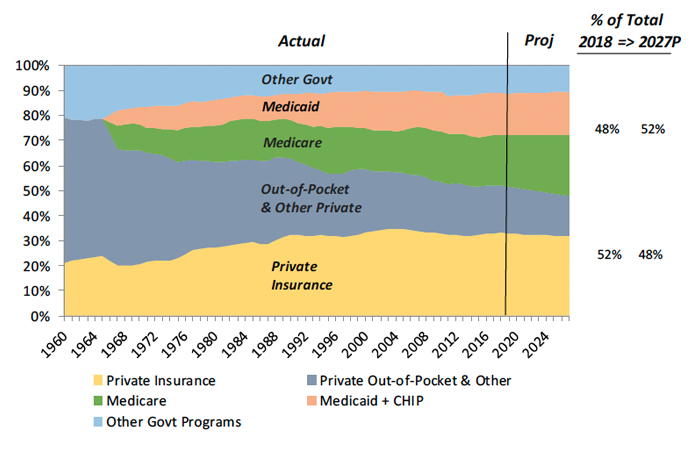
Making Health Care Affordable
While there is much debate about the quality of health care in the U.S., there is no question that it is costly. Even as the COVID-19 pandemic has waned, U.S. national health expenditures are projected to approach $4.5 trillion in 2022. On a per capita basis, we spend almost twice as much as any other advanced OECD country: $12,300 (17.8% of GDP) vs. $6,400 (12.8% of GDP) for Germany, the second highest spender in 2020.
The reasons given for this gap reach from here to the moon and back – everything from tax breaks to overutilization of unnecessary medical services to monopolistic behavior by hospital systems and pharmaceutical manufacturers to the influx of private equity in healthcare. For a discussion of the most important drivers, see the IAHC white paper, “Why Are Our Health Care Costs So High.”
One factor that is rarely mentioned, however, has nothing to do with U.S. health care. It is a common characteristic of the other countries we compare ourselves to: Pricing of health care services in European OECD countries is heavily regulated by governments because most health care services are funded by taxpayers, and taxpayer funding is inherently limited by political realities. While about half of health care expenses in the U.S. are funded by taxpayers, we still have a viable private sector that is not constrained by taxpayer $.
It turns out that when national governments impose price controls over an entire sector of the economy and negotiate directly with suppliers, they can succeed in keeping prices down. Because governments control prices, either directly as in Canada and the UK, or indirectly through taxpayer-funded insurance companies as in Germany and Switzerland, drugs and equipment are cheaper, hospitals cost less, and doctors and nurses are paid less than in the U.S.
Progressives in the Democratic Party have been promoting European-style “national health insurance” or “single payer” systems for over a century, and many U.S. health care experts are advocates for this model of government-driven price controls. They believe that “healthcare is a right” and government should guarantee a high level of quality and service to all residents, irrespective of their ability to pay. They believe variation in health services and outcomes should be addressed through taxpayer funding in order to promote “health equity.” The Biden administration has made health equity a central focus of as many CMS programs as possible.
This progressive vision has been the driving force behind health care policy since Medicare and Medicaid were enacted in 1965. The following chart shows how the composition of national health expenditures has changed since 1960:
% of National Health Expenditures

This chart illustrates two long-term trends:
- Private insurance has grown to replace a good deal of private out-of-pocket spending.
- Government programs have steadily displaced private health care services in the market.
The growth of health insurance has been a significant benefit to employees and their families who are now able to protect themselves against unexpected financial hardships. At the same time, insurance is inherently less efficient than out-of-pocket spending and this shift has undoubtedly contributed to growth in health care spending.
As for government programs, Medicare and Medicaid clearly provide important health care services to people who cannot afford to pay for them. At the same time, both programs have expanded far beyond their original scope, impose substantial tax burdens on working people, and have become fiscal albatrosses for the nation. Medicare alone spends more than twice as much per capita on people 65 and over as any other country in the world.
What We Believe
We believe the progressive concept of health care as a “right” guaranteed by government is fundamentally flawed. Health care is a good, not a right. Health care services are enormously varied, and it is impossible to define and enforce a “right” that encompasses them all. Governments can, of course, define specific types of services (i.e., “goods”) and either: (1) pay for them directly with taxpayer dollars; or (2) force private companies to provide them (e.g., EMTALA’s mandate that all licensed acute care hospitals provide emergency services). Calling health care a “right,” however, obligates government to provide an ever-expanding list of health care services, limited only by the willingness of taxpayers to foot the bill. In other words, it creates a fast track to insolvency.

It is no coincidence that as our % of taxpayer-funded health care has increased, our national health expenditures have distanced themselves from other OECD countries. (In 1975, Germany and Denmark both outspent the U.S. as a % of GDP.) From a cost standpoint, we now have the worst of both worlds: the health care expectations of a privately insured population and an enormous government bureaucracy that allocates taxpayer money and tries to keep up with the private market.
We have to decide where our health care sector is going. We need to either: (1) accelerate our move to replace employer-sponsored health insurance with taxpayer-funded “single payer” health care; or (2) reinvigorate the market for private health insurance and health care services. Our current hybrid system is simply too complex and expensive to maintain.
We believe that we will be much better off going down the second path: reinvigorating private health care in the U.S. and returning our major public programs to the “safety net” functions they were originally designed to perform. Taxpayer-funded health sectors like those in Europe have many drawbacks:
- They create shortages and queues for services.
- They limit capital formation – e.g., building needed hospitals, ambulatory services, etc.
- They promote regulation and bureaucracy which imposes substantial costs.
- They stifle competition.
- They inhibit innovation.
In addition, health care in Europe and other parts of the world are able to achieve quality care at lower costs partly by “free-riding” on U.S.-funded research, development, and innovation.
A number of economists and health policy experts have come up with creative and achievable ways to reverse course and recommit to private health care. Fundamentally, however, we must change public attitudes about health care and its costs. “Single payer” advocates have convinced most people, including many Republicans, that taxpayer-funded health care is cheaper than private health care. In large part, this perception arises because Medicare and Medicaid have “negotiated” lower rates with providers and forced private insurers to pay more to keep hospitals operating and doctors in business. Without these cross-subsidies, taxpayer-funded patients would face severe shortages and sharply reduced quality of care.
Reversing course will also require reducing CMS’s bureaucratic and economic control over health care markets. As the world’s largest bureaucracy, CMS imposes regulations and sets base rates that define the terms of trade for the entire sector. Reducing its regulatory reach and shrinking its role as a payer would unleash competition and innovation that would drive down cost. If we take these steps, we will likely find that, as in other industries, high quality privately funded health care costs less than taxpayer-supported health care.
Reversing course and revitalizing private health care should be the goal of any conservative health reform movement. It will be a hard path to follow, because replacing government programs that benefit large groups of voters is very difficult to do. (Just ask former Speaker of the House Paul Ryan.) Over time, however, it should be possible, simply because our taxpayer-funded programs are rapidly becoming unaffordable. Re-privatizing is the only viable path to high quality, fiscally sound health care.
Latest Blog Posts
CDC Guidance for Vaccinated People: What Are They Thinking?
Thank God (and Moderna) that I’ve finally gotten my two COVID-19 vaccinations and waited two weeks to become “fully vaccinated”! Now I can resume a normal life, free from fears that I will contract the disease or pass it along to others. Right? Well…not really. The CDC today released its “Interim Public Health Recommendations for…
Regulatory Purgatory
A recent article in Modern Healthcare shows how CMS regulations can tie providers into knots and add administrative costs.[1] Every mail-order company and shipper in America, including USPS, UPS, and FedEx, all work with inexact address data. Apartment or suite numbers are left off, “Drive†is abbreviated as “Dr†or “Dr.â€, names are misspelled, and…
The Trump Administration’s Response to COVID-19
With the recent resurgence in coronavirus cases, the Trump administration is being vilified by Democrats and the media (and some Republicans) for mishandling the COVID-19 pandemic. It’s too early to write a full and fair history of our nation’s response to the pandemic. But if you step back and review the administration’s actions, they responded…

Leave a Reply